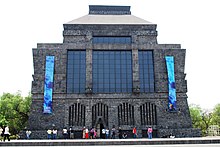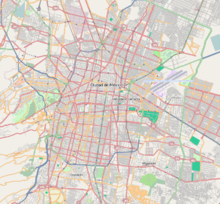Anahuacalli Museum
| Museo Diego Rivera Anahuacalli | |

Front view
|
|
| Established | 1964 |
|---|---|
| Location | Museo 150, San Pablo Tepetlapa, 04620, Coyoacán, Mexico City, Mexico |
| Coordinates | 19°19′21″N 99°08′39″W / 19.32250°N 99.14417°W |
| Architect | Juan O'Gorman and Heriberto Pagelson |
| Website | www |
The Museo Diego Rivera Anahuacalli or simply Anahuacalli Museum is a museum located in Coyoacán, in the south of Mexico City.
The unique museum was conceived and created by muralist, Diego Rivera, who, motivated by his own interest in Mexican culture, collected nearly 50,000 pre-Hispanic pieces during his life, and projected a building to place and exhibit them. Rivera and his wife, the painter, Frida Kahlo, intended to build two museums as a legacy for Mexico. The house that he and Kahlo lived in, known as La Casa Azul (The Blue House) now houses the Frida Kahlo Museum and is located 3.1 miles away, in the heart of the former village of Coyoacán. The Anahuacalli was completed after Rivera's death by architects, Juan O'Gorman and Heriberto Pagelson as well as Rivera's own daughter, Ruth. In addition, the twin home-studios that O'Gorman designed for the couple, in nearby San Angel, has also become a museum, .
The Anahuacalli is built of black volcanic stone (obtained from the terrain in which the Xitle volcano erupted). It takes the form of a pyramid. The museum items are collected from almost every indigenous civilization in Mexico's history. On the second floor, there is an exhibition room dedicated to the life and works of Rivera, as well as an observation deck.
The word Anahuacalli literally means "house of Anahuac" in Nahuatl.
The building forms a teocalli (god-house), and its design is notably influenced by the Teotihuacan culture as can be appreciated in the building’s boards, recreating the image of the rain god, Tlaloc. It also shows Maya and Aztec influences, which can be seen in the hexagonal (Maya) and rectangular (Aztec) arcs that serve as entrances to the different showrooms.
...
Wikipedia

